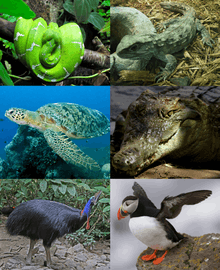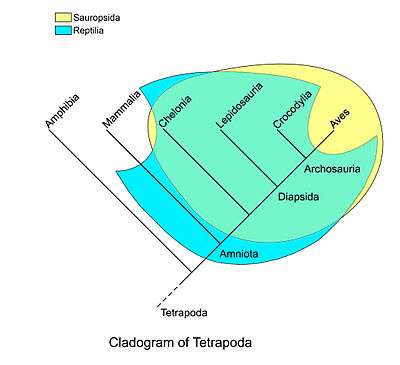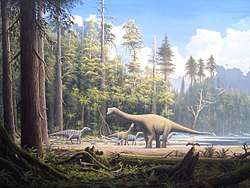Sauropsida
Sauropsida ("lizard faces") is a taxonomic clade that consists of reptiles, birds, and the extinct Parareptilia. The term originated in 1864 with Thomas Henry Huxley,[1] who grouped birds with reptiles based on fossil evidence. Sauropsids are the sister taxon to synapsids (often mistakenly referred to as "mammal-like reptiles", as synapsids are not reptiles), some of which later evolved into mammals.
| Sauropsids | |
|---|---|
 | |
| Row 1: emerald tree boa and tuatara Row 2: green sea turtle and Nile crocodile Row 3: Southern cassowary and Atlantic puffin | |
| Scientific classification | |
| Kingdom: | Animalia |
| Phylum: | Chordata |
| Superclass: | Tetrapoda |
| Clade: | Reptiliomorpha |
| Clade: | Amniota |
| Clade: | Sauropsida Watson, 1956 |
| Subclades | |
| |
History of classification
Huxley and the fossil gaps

The term Sauropsida ("lizard faces") has a long history, and hails back to Thomas Henry Huxley, and his opinion that birds had risen from the dinosaurs. He based this chiefly on the fossils of Hesperornis and Archaeopteryx, that were starting to become known at the time.[2] In the Hunterian lectures delivered at the Royal College of Surgeons in 1863, Huxley grouped the vertebrate classes informally into mammals, sauroids, and ichthyoids (the latter containing the anamniotes), based on the gaps in physiological traits and lack of transitional fossils that seemed to exist between the three groups. Early in the following year he proposed the names Sauropsida and Ichthyopsida for the two latter.[1] Huxley did however include groups on the mammalian line (synapsids) like Dicynodon among the sauropsids. Thus, under the original definition, Sauropsida contained not only the groups usually associated with it today, but also several groups that today are known to be in the mammalian side of the tree.[3]
Sauropsids redefined
By the early 20th century, the fossils of Permian synapsids from South Africa had become well known, allowing palaeontologists to trace synapsid evolution in much greater detail. The term Sauropsida was taken up by E.S. Goodrich in 1916 much like Huxley's, to include lizards, birds and their relatives. He distinguished them from mammals and their extinct relatives, which he included in the sister group Theropsida (now usually replaced with the name Synapsida). Goodrich's classification thus differs somewhat from Huxley's, in which the non-mammalian synapsids (or at least the dicynodontians) fell under the sauropsids. Goodrich supported this division by the nature of the hearts and blood vessels in each group, and other features such as the structure of the forebrain. According to Goodrich, both lineages evolved from an earlier stem group, the Protosauria ("first lizards"), which included some Paleozoic amphibians as well as early reptiles predating the sauropsid/synapsid split (and thus not true sauropsids).[3]
Detailing the reptile family tree
In 1956, D.M.S. Watson observed that sauropsids and synapsids diverged very early in the reptilian evolutionary history, and so he divided Goodrich's Protosauria between the two groups. He also reinterpreted the Sauropsida and Theropsida to exclude birds and mammals respectively, making them paraphyletic, unlike Goodrich's definition. Thus his Sauropsida included Procolophonia, Eosuchia, Millerosauria, Chelonia (turtles), Squamata[4] (lizards and snakes), Rhynchocephalia, Crocodilia, "thecodonts" (paraphyletic basal Archosauria), non-avian dinosaurs, pterosaurs, ichthyosaurs, and sauropyterygians.[5]
This classification supplemented, but was never as popular as, the classification of the reptiles (according to Romer's classic Vertebrate Paleontology[6]) into four subclasses according to the positioning of temporal fenestrae, openings in the sides of the skull behind the eyes. Since the advent of phylogenetic nomenclature, the term Reptilia has fallen out of favor with many taxonomists, who have used Sauropsida in its place to include a monophyletic group containing the traditional reptiles and the birds.
Cladistics and the Sauropsida

The class Reptilia has been known to be an evolutionary grade rather than a clade for as long as evolution has been recognised. Reclassifying reptiles has been among the key aims of phylogenetic nomenclature.[7] The term Sauropsida had from the mid 20th century been used to denote all species not on the synapsid side after the synapsid/sauropsid split, a branch-based clade. This group encompasses all now-living reptiles as well as birds, and as such is comparable to Goodrich's classification, the difference being that better resolution of the early amniote tree has split up most of the Goodrich's "Protosauria", though definitions of Sauropsida essentially identical to Huxley's (i.e. including the mammal-like reptiles) are also forwarded.[8][9] Some later cladistic work has used Sauropsida more restrictively, to signify the crown group, i.e. all descendants of the last common ancestor of extant reptiles and birds. A number of phylogenetic stem, node and crown definitions have been published, anchored in a variety of fossil and extant organisms, thus there is currently no consensus of the actual definition (and thus content) of Sauropsida as a phylogenetic unit.[10]
Some taxonomists, such as Benton (2004), have co-opted the term to fit into traditional rank-based classifications, making Sauropsida and Synapsida class-level taxa to replace the traditional Class Reptilia, while Modesto and Anderson (2004), using the PhyloCode standard, have suggested replacing the name Sauropsida with their redefinition of Reptilia, arguing that the latter is by far better known and should have priority.[10]
Evolutionary history

Sauropsids evolved from basal amniotes stock approximately 320 million years ago in the Paleozoic Era. In the Mesozoic Era (from about 250 million years ago to about 66 million years ago), sauropsids were the largest animals on land, in the water, and in the air. The Mesozoic is sometimes called the Age of Reptiles. Sixty-six million years ago, the large-bodied sauropsids died out in the global extinction event at the end of the Mesozoic era. With the exception of a few species of birds, the entire dinosaur lineage became extinct; in the following era, the Cenozoic, the remaining birds diversified so extensively that, today, nearly one out of every three species of land vertebrate is a bird species.
Phylogeny
The cladogram presented here illustrates the "family tree" of sauropsids, and follows a simplified version of the relationships found by M.S. Lee, in 2013.[11] All genetic studies have supported the hypothesis that turtles are diapsid reptiles; some have placed turtles within archosauromorphs,[11][12][13][14][15][16] though a few have recovered turtles as lepidosauromorphs instead.[17] The cladogram below used a combination of genetic (molecular) and fossil (morphological) data to obtain its results.[11]
| Sauropsida |
| |||||||||||||||||||||||||||||||||||||||||||||||||||||||||||||||||||||||||||||||||||||||||||||||||||||||||||||||||||||||||||||||||||||||||||||
References
- Huxley, T.H. (1863): The Structure and Classification of the Mammalia. Hunterian lectures, presented in Medical Times and Gazette, 1863. original text
- Huxley, T.H. (1876): Lectures on Evolution. New York Tribune. Extra. no 36. In Collected Essays IV: pp 46-138 original text w/ figures
- Goodrich, E.S. (1916). "On the classification of the Reptilia". Proceedings of the Royal Society of London. 89B (615): 261–276. doi:10.1098/rspb.1916.0012.
- Reeder, Tod W.; Townsend, Ted M.; Mulcahy, Daniel G.; Noonan, Brice P.; Jr, Perry L. Wood; Jr, Jack W. Sites; Wiens, John J. (24 March 2015). "Integrated Analyses Resolve Conflicts over Squamate Reptile Phylogeny and Reveal Unexpected Placements for Fossil Taxa". PLOS ONE. 10 (3): e0118199. doi:10.1371/journal.pone.0118199. PMC 4372529. PMID 25803280.
- Watson, D.M.S. (1957). "On Millerosaurus and the early history of the sauropsid reptiles". Philosophical Transactions of the Royal Society of London. Series B, Biological Sciences. 240 (673): 325–400. doi:10.1098/rstb.1957.0003.
- Romer, A.S. (1933). Vertebrate Paleontology. University of Chicago Press., 3rd ed., 1966.
- Gauthier, .A., Kluge, A.G & Rowe, T. (1988). The early evolution of the Amniota. Pages 103–155 in Michael J. Benton (ed.): The Phylogeny and Classification of the Tetrapods, Volume 1: Amphibians, Reptiles, Birds. Syst. Ass. Spec. Vol. 35A. Clarendon Press, Oxford.
- Laurin, M. & Gauthier, J.A. (1996). Amniota, Mammals, reptiles (turtles, lizards, Sphenodon, crocodiles, birds) and their extinct relatives. Version 01 January 1996. The Tree of Life Web Project.
- Pearse, A.S. (ed, 1947): Zoological Names: a List of Phyla, Classes, and Orders. Prepared for Section F, American Association for the Advancement of Science. Second edition. Durham, North Carolina, U.S.A., pp. 1-22
- Modesto, S.P.; Anderson, J.S. (2004). "The phylogenetic definition of Reptilia". Systematic Biology. 53 (5): 815–821. doi:10.1080/10635150490503026. PMID 15545258.
- Lee, M. S. Y. (2013). "Turtle origins: Insights from phylogenetic retrofitting and molecular scaffolds". Journal of Evolutionary Biology. 26 (12): 2729–2738. doi:10.1111/jeb.12268. PMID 24256520.
- Mannen, Hideyuki; Li, Steven S. -L. (Oct 1999). "Molecular evidence for a clade of turtles". Molecular Phylogenetics and Evolution. 13 (1): 144–148. doi:10.1006/mpev.1999.0640. PMID 10508547.
- Zardoya, R.; Meyer, A. (1998). "Complete mitochondrial genome suggests diapsid affinities of turtles". Proc Natl Acad Sci U S A. 95 (24): 14226–14231. Bibcode:1998PNAS...9514226Z. doi:10.1073/pnas.95.24.14226. ISSN 0027-8424. PMC 24355. PMID 9826682.CS1 maint: ref=harv (link)
- Iwabe, N.; Hara, Y.; Kumazawa, Y.; Shibamoto, K.; Saito, Y.; Miyata, T.; Katoh, K. (2004-12-29). "Sister group relationship of turtles to the bird-crocodilian clade revealed by nuclear DNA-coded proteins". Molecular Biology and Evolution. 22 (4): 810–813. doi:10.1093/molbev/msi075. PMID 15625185.
- Roos, Jonas; Aggarwal, Ramesh K.; Janke, Axel (Nov 2007). "Extended mitogenomic phylogenetic analyses yield new insight into crocodylian evolution and their survival of the Cretaceous–Tertiary boundary". Molecular Phylogenetics and Evolution. 45 (2): 663–673. doi:10.1016/j.ympev.2007.06.018. PMID 17719245.
- Katsu, Y.; Braun, E. L.; Guillette, L. J. Jr.; Iguchi, T. (2010-03-17). "From reptilian phylogenomics to reptilian genomes: analyses of c-Jun and DJ-1 proto-oncogenes". Cytogenetic and Genome Research. 127 (2–4): 79–93. doi:10.1159/000297715. PMID 20234127.
- Tyler R. Lyson; Erik A. Sperling; Alysha M. Heimberg; Jacques A. Gauthier; Benjamin L. King; Kevin J. Peterson (2012-02-23). "MicroRNAs support a turtle + lizard clade". Biology Letters. 8 (1): 104–107. doi:10.1098/rsbl.2011.0477. PMC 3259949. PMID 21775315.